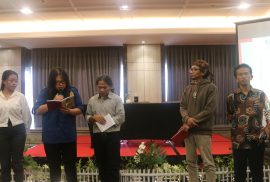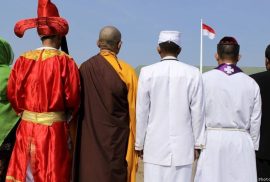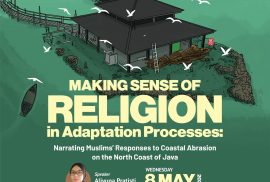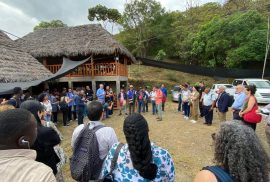Hongsok Lee
The Wednesday forum, held on February 28, 2024, at the Graduate School Building of Universitas Gadjah Mada, was an interesting presentation entitled “The Joke is on Me (God).” The speaker, Prof. Robert Setio, is the Dean of the Faculty of Theology at Universitas Kristen Duta Wacana and a faculty member of the Indonesian Consortium for Religious Studies.
The presentation began by listening to the song “I started a Joke” by the Bee Gees together and discussing the meaning of the lyrics. The presenter went on to quote Søren Kierkegaard on irony: “Irony limits, finitizes, and circumscribes and thereby yields truth, actuality, and content; it disciplines and punishes and thereby yields balance and consistency.” Through his examination of the role that humor about God can play in uncovering the irony of religion and the meaning of humanity, he argues that humor about God can be a good tool for understanding the complexity and diversity of religion and humanity.
Humor can be a great tool to help us see another side of a story that we may have missed because we were only seeing one side. Using the crucifixion of Christ as an example, the presenter emphasized that although people tend to focus more on the value of suffering and take it more seriously, it is important to remember that the joy behind suffering is equally valuable.
Throughout his presentation, he shared several examples of religion-related or religious humor. These examples made the audience laugh while clearly demonstrating the similarities and differences between different religious traditions. Here are two examples of humor from the presentation, which clearly show the similarities and differences between different religious traditions in a way that is profound but not serious and boring.
A Christian asked a Zen Buddhist, “What is the essence of your teaching?” The Zen Buddhist replied, “What is the essence of your teaching?” The Christian said, “To love God with all your heart and to love your neighbor as yourself.” The Zen Buddhist nodded and said, “We also have that teaching, only we add: No one and nothing is your neighbor.”
As Professor Robert intended, the humor in the Zen Buddhist monk’s short answer clearly illustrates the similarities and differences between religions. The essential Christian teaching of love of God and love of neighbor, or the Golden Rule, can be found in many other religious traditions. The differences found among religions are in the ways in which they practice them. The audience may have laughed at the Zen Buddhist monk’s answer for a moment, but then thought more deeply about the religious meaning behind it—that’s how humor can help us discover deeper meaning in religion.
Here is another story.
I went to an inter-religion integration seminar.
The Bishop came, laid his hands on my hand and said, “By the will of Jesus Chrst, you will walk today!” I smiled and told him I was not paralyzed.
The Rabbi came, laid his hand on my hand and said, “By the will of God Almighty, you will walk today!” Less amused, I told him there was nothing wrong with me”
The Mullah came, took my hands and said, “Insha Allah, you will walk today!” I snapped at him, “There’s nothing wrong with me”
The Hindu sadhu came and said, “Beta, you will walk on your legs today!” I said, “Babaji – nothing wrong with my legs”
The Buddhist Monk came, held my hands and said, “By the will of The Great Buddha, you will walk today!” I rudely told him there is nothing wrong with me.
After the Seminar, I stepped outside and found my bicycle had been stolen.
The story features leaders from different religious traditions. As the protagonist meets and talks with the leaders of each religious tradition, he encounters a rather unusual situation: each of them uses the terminology of their respective religious tradition, but in the end, they all testify to the same thing: the protagonist’s bike has been stolen and he has to walk. Sometimes, the similarities between different religious traditions can be uncomfortable for some people, and they may not want to talk about them. However, humor has the power to make the atmosphere much lighter, allowing the audience to see the other side of the coin.
Given his position as an academic who teaches theology and religious studies in a country where religion holds an important place, the topic of the day may seem a bit risky. The atmosphere of the lecture, which was attended by scholars and students from various religious traditions, was light and full of laughter. This was perhaps a practical demonstration of the role of humor in interfaith relations that the presenter was trying to show.














